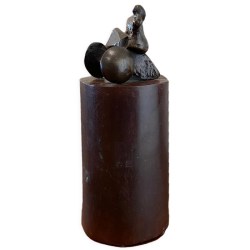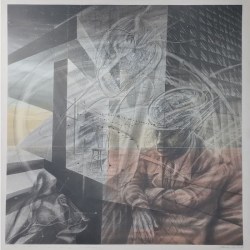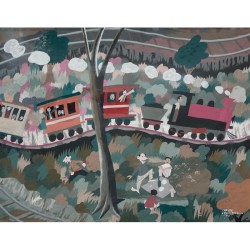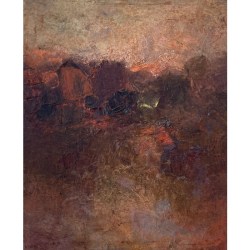Bio
 José Manuel Rodríguez Mariano Alvarez born, August 24, 1912 in Havana. Her mother Amelia Alvarez Alvarez parents from Asturias, was a student of the academic painters Romañach and Menocal. His father Jose Mariano Rodríguez Cabrera, born in Santa Cruz de la Palma, Canary Islands, where he lived from three to eight years.
José Manuel Rodríguez Mariano Alvarez born, August 24, 1912 in Havana. Her mother Amelia Alvarez Alvarez parents from Asturias, was a student of the academic painters Romañach and Menocal. His father Jose Mariano Rodríguez Cabrera, born in Santa Cruz de la Palma, Canary Islands, where he lived from three to eight years.
In 1928 he entered the Secondary School of Havana, to attend high school. Request enrollment in the School of Fine Arts San Alejandro in Havana, in the course of natural drawing and modeling. After high school began to draw and enter the second time in San Alejandro. In 1936 he was appointed artistic director of Rhythm magazine. In October he traveled to Mexico with the sculptor Alfredo Lozano, he participated in the National Congress of Writers and Artists organized by the League of Revolutionary Writers and Artists (LEAR), held in 1938 at the Palacio de Bellas Artes in Mexico City. Return to Cuba in June of that year where it forms part of the Free Study of Painters and Sculptors as adviser and assistant instructor of mural painting in other areas.
In 1938 he exhibited for the first time in a collective exhibition in the "Second National Exhibition of Painting and Sculpture," which presents the works "Zora" and "Unity", the latter obtained the third prize. Magazine is published in the graphs, the first single review of his work signed by Ramon Guirao. The following year he painted the mural fresco "Sex Education" at the Normal School for Teachers of Santa Clara. Attend the National Congress of Art in Santiago de Cuba, where he expresses his vote against the attempt by the Commission Paint condemn modern art. During this year he made the plays "The thread" and children of the well. Presented his first personal exhibition at the Lyceum, Havana, sponsored by Victor Manuel. Part of the direction of artistic and literary magazine Silver Spur (1939-1941).
In the decade of the 40 states in the exhibition "300 Years of Cuban Art" at the University of Havana. He paints "The Dove of Peace" and "Woman with birdhouse" Enemy Rumor illustrated, book of poems by José Lezama Lima. Start work on the issue of roosters with "gallo pinto", which exposes with "Man peeling potatoes" and other works in the exhibition "Contemporary Cuban Art." Together with a group of Cuban Painters decorate the windows of the store El Encanto, works the subject of Havana.
In 1944 participates in "Twelfth International Biennial Water Color Exhibition," Brooklyyn Museum and "The First International Exhibition of watercolor and gouache," Hispanic Cuban Institute of Culture, Havana. Make the murals "Descent" and "Resurrection" for the church of Bauta.
Committee is part of the editor of "Origins", since its foundation in the first number is a drawing of him on the cover 1945. Travel to the United States, disclosed in Feigl Gallery, New York. Illustrate "Stealthy Adventures", by José Lezama Lima, editions "Origins" Havana, 1945.
In 1948 he traveled to the United States and exhibited again at the Feigl Gallery, New York. Participate in the organization and creation of the Association of Painters and Sculptors of Cuba (APEC), founded in November of that year. Illustrates the book Poems I. Elegies, by Lorenzo García Vega, Ediciones Origins, La Habana, 1948.
The exhibition "Lozano, Mariano" in the Lyceum, Havana presents "Reading origins." Céspedes illustrating the book, the precursor of Rafael Esténger and the cover of The road of Jesus del Monte, Eliseo Diego. Destroys about fifty-five works of its production. Make the windows of the Virgin of Fatima and St. Joseph in the Church of Bauta. In 1950 he pays in painting at the IV National Salon of Painting, Sculpture and Engraving, with Fisher's work. Start decorating pottery workshop in Santiago de las Vegas. The following year he exhibited for the last time Feigl Gallery, New York. Participate in the V National Exhibition of Painting, Sculpture and Engraving, and "Art Contemporain Cubain" at the Museum of Modern Art, Paris.
In 1952 he exhibited for the second time with the sculptor Alfredo Lozano at the Lyceum. Start the mural fresco human suffering in the lobby of the building of Dental Retiro, La Habana (now School of Economics).
His works are included in the permanent galleries of Art, opened in the Palace of Fine Arts. It appears in the Lyceum, the retrospective exhibition "Landscape and Figure," which includes works between 1942 and 1955. His latest production is presented in the Gallery Cubana, La Habana. This year is his "Juggling".
In 1956 he made a ceramic mural in the building of medical retirement at the entrance by N Street in Havana. Participates in the exhibition "Homage to Guy Pérez Cisneros," Lyceum. His "Gallo yellow" won the prize at the Eighth National Exhibition of Painting and Sculpture. Travel through Italy, France, Portugal, Spain and the United States in 1957 and the following year to Venezuela where he exhibited at the Museum of Fine Arts of Caracas and the Centro de Bellas Artes de Maracaibo. One of the exhibits, the garden becomes part of the museum's permanent collection. The exhibition gets a huge success with audiences and critics.
In 1959, after a journey of several socialist countries, in New York attending the exhibition "New paint in the United States," presented at the Museum of Modern Art. Two works exhibited at the 5th Biennial of Sao Paulo, Brazil.
Six of his works are included in the exhibition "Cuban Contemporary Painting" that runs through Mexico, Brazil, Venezuela and Uruguay. He is appointed Cultural Counsellor in India, partly to that country in May. Plays an important series of drawings and paintings. Do one of the most important works of this period: "Jama Mosque delicacy".
In 1961 he returned to Cuba where he participated in the First Congress of Writers and Artists of Cuba is appointed to chair the Visual Arts section of the UNEAC was in office until 1963.
Start working in the Casa de las Americas where he was appointed director of the Fine Arts Department in 1970 was appointed vice president this institution.
Gallery opens an exhibition Havana Mariano Rodriguez and words in the catalog by José Lezama Lima. Participates in the "Exhibition of Cuban Painting," which will travel to six socialist countries. In 1963 presented in the VII Bienal de Sao Paulo.
In 1967 began his series Fruits and reality, which will last approximately until 1973, participating in the "Salon de Mai", Paris, and integrates a group of Cuban artists and foreigners who run the collective mural that takes place during the presentation of this room in Havana in July of that year. Is delegated to the Cultural Congress of Havana in the 68 and his works are included in the exhibition "Cuban Masters," presented in Mexico City, to celebrate the Olympics in that city.
In 1980 he premiered the documentary Mariano, led by Marisol Trujillo. Moves to the position of president of the Casa de las Americas. Works from the series exhibited at the National Museum masses. Havana. The National Ballet of Cuba, Fruits and reality premieres, choreographed by Gladys Gonzalez, created from your plastic at the VII International Ballet Festival of Havana.
In 1981 Felix Varela received the order of first grade, highest honor that the State Council of the Republic of Cuba granted to senior figures of culture. Elected deputy to the National Assembly. Chairs the Meeting of Intellectuals for the Sovereignty of the Peoples of Our America. He makes his "Retrospective (1937-1981)" at the Museum of Modern Art in Mexico and one in the room Benjamín Carrión, Casa de Cultura de Guayaquil, Ecuador. Travel to Ecuador to join the jury of the First Prize at the National Exhibition of Paintings XV Foundation Guayaquil. Mounts to the House of Culture of the town square, a joint exhibition of Mariano, Rene Portocarrero and Luis Martínez Pedro. In 1989 he received the title of Doctor Honoris Causa in Art Institute of Art and Haydee Santamaria Medal. He died in Havana on May 26, 1990.







